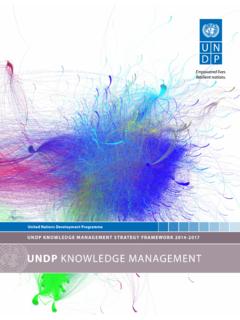Transcription of I. The advantages of developing life insurance - OECD.org
1 1 developing life insurance IN THE ECONOMIES IN TRANSITIONOECD SecretariatI. The advantages of developing life individual financial securityA study of human history reveals a universal desire for This quest for security has beena potent motivating force in material and cultural growth. Early societies relied exclusively on family andtribe cohesiveness for their security. With industrial development, this security source weakened, beingaugmented by privately purchased and government-provided security programs. Among the privateprograms, life insurance has been a universal the individual s perspective, life insurance offers many advantages : life insurance guarantees to pay a stated sum to a family on the death of its income earner(s). In sodoing, it affords families a measure of protection against the adverse financial consequences ofpremature death, gives individuals a greater sense of economic security, and can help reduce worry anddistress and thereby increase No other privately purchased financial instrument can performthis function.
2 Cash value life insurance can serve as a means through which individuals save. Many persons whomight not otherwise save consistently will, nonetheless, regularly pay their life insurance premiums;thus, life insurance might constitute a type of quasi-compulsory savings. life insurance products, especially annuities, provide a convenient, if not unique, means by whichindividuals can make financial provisions for retirement. 1 This section draws on Kenneth Black, Jr. et harold D. Skipper, Jr. called life insurance , 12 Edition (EnglewoodCliffs, : Prentice-Hall, Inc., 1994), Chap. See UNCTAD (1982), The Promotion of life insurance in developing Countries, life insurance can permit more favourable credit terms to borrowers both individuals and businesses and can decreases the risk of default. life insurance can also minimize the financial disruption tobusinesses caused by the death of key the burden of government social welfare spendingPrivate life insurance can supplement, if not substitute for, benefits provided by government.
3 Thisassertion is substantiated by a significant negative correlation between social spending and life insurancepremiums. Moreover, the sharp rise in life premiums in the OECD countries may be attributed in great partto the mounting financial difficulties of pension schemes. Governments can now concentrate their effortson core social protection benefits, while allowing individuals to choose for themselves their desired leveland type of additional on economic developmentApart from the social role it plays by relieving government of some of the burden of meetingfinancial security needs, life insurance can assist economic development in general and the development offinancial markets in particular. Because they have thousands of policyholders, insurance companies areable to amass quantities of funds that are important in supporting investment and the national thereby serve as financial intermediaries between investors and economic agents that lack sufficientfinancing: households, businesses and in some cases even governments.
4 The emergence of this new type ofintermediaries, with features different from those of banks, with regard to the timeframe of investment inparticular, makes a major contribution to the development of financial markets. In the OECD countries, insurance companies are the largest institutional impact on savingsA great many studies have looked at how the development of life insurance and funded pensionschemes have impacted the level of aggregate savings. When such schemes are instituted, they generallyhave a positive number of arguments have been advanced to explain this. First, when they are instituted on acompulsory basis, contractual savings plans ( life insurance and pension funds) raise the level of aggregate3savings if they involve a rate of mandatory savings that is higher than the rate for which households wouldhave opted addition, if a system that is still recent lacks credibility, households are not necessarily inclinedto alter their prior savings behaviour, because the new products do not give them the level of financialsecurity they desire.
5 As a result, they increase their rate of savings. This latter effect is only temporary,however, and it goes away when the system becomes more mature and thus more credible. It should benoted, however, that the long-term impact of a temporary rise in the savings rate could be very important ifthe funds are invested wisely and prompt a virtuous circle of growth and , the development of contractual savings also encourages savings by offering individualsand businesses a way to diversify their assets. Not forgetting, however, that the subsequent increase inaggregate savings may only be slight if consumers merely shift their funds between different types ofinvestments but keep the overall level of their savings impact on savingsWhile there may be some doubt as to the quantitative impact on savings of the development oflife insurance , the qualitative impact is very clear: unlike many commercial banks specialising in deposit-taking and short-term lending, contractual savings institutions usually adopt a longer-term longer-term commitments and the stability of their cash flow provide ideal sources of term financingfor governments and on the development of financial marketsThe development of contractual savings is greatly increasing the supply of long-term financialproducts, thereby triggering a series of effects on the development and structure of the financial markets.
6 Specialisation in the sector, insofar as the banking system is making adjustments in order toreap the benefits of its comparative advantage on short-term products. This has prompted asharp reduction in risk stemming from maturity differentials between bank assets andliabilities. The stability of the banking system is therefore reinforced. Reduction of the differential between short- and long-term interest rates (the rate curve isbecoming flatter). This is prompting an improvement in the financial structure of business4enterprises thanks to a lowering of the cost of long-term capital and a lessening of the risks ofrefinancing. Reduction of the implicit debt of defined-benefit pension schemes. Development of the market for long-term government bonds, which greatly expands theoptions for government debt management. This argument has also been used against thedevelopment of contractual savings, out of a fear that without a sufficiently developed bondmarket, the funds accumulated by life insurance companies and pension funds might becomecaptive sources of financing for the government s deficit.
7 Implementation of sufficientlyflexible investment regulations, allowing insurance companies and pension funds to diversifytheir investments in equity markets and in international markets should be sufficient to avoidthis pitfall. Enhancing the efficiency of financial markets. Contractual savings institutions, like allmutual investment instruments, prompt a higher level of specialisation and professionalismon the part of financial market players, making it possible to finance projects that are bolderor riskier (and thus more lucrative), exploiting economies of scale, trimming transaction costsand encouraging financial innovation. Furthermore, such institutions are able to exercisetighter control over the performance of businesses they finance and thus help to improvecorporate management and foster greater The life insurance market in economies in transition : taking penetration of life insurance in the emerging marketsLife insurance is still fairly undeveloped in the Baltic States, as in all Europe s emerging markets,since in 1998 the penetration of life insurance (direct gross premiums / GDP) was only in theCentral and Eastern European countries and the new independent states3.
8 Premiums ranged from inRomania to in Slovakia and in Slovenia. In comparison, in 1998 the OECD countriesdevoted of their aggregate GDP to life insurance . : insurance Regulation and Supervision in OECD Countries, Asian Economies and CEEC and NISC ountries, OECD. The countries in question are: Albania, Armenia, Belarus, Bulgaria, Croatia, Estonia,Latvia, Lithuania, Moldova, Romania, Russia, Slovakia (OECD Member State since 2000), Slovenia timid development of life insurance is also plain to see from the clear domination of non-lifeinsurance in total premiums: in 1998, life insurance accounted for only 16% of total premiums in theCentral and Eastern European countries and the new independent states1, the percentages in each countryranging from nearly 30% in Russia and Slovakia2 to less than 2% in Ukraine. In comparison, life insuranceaccounted for of total insurance premiums in the OECD countries in low volume of life insurance business stems, first, from the role played by governmentprovident schemes.
9 But the State s involvement varies widely from one country to prospects for growthAlthough the levels of their life insurance premiums have remained fairly low, the countries ofCentral and Eastern Europe have recorded sharp growth rates for those premiums in many cases inexcess of 10% over the past decade, with the notable exception of Russia, where life insurance premiumsregistered a fact that the penetration rate of life insurance is still lower in the emerging markets of Europethan it is in other emerging markets4 gives hope that growth rates will remain high. In candidates formembership of the European Union in particular, further financial market deregulation and adoption ofnew Community directives ought to give growth in these markets a of the insurance of life and non- life businessAmong the insurance companies operating in the emerging markets, few are with Bulgaria and Ukraine, the Baltic countries are an exception: all of the Central and EasternEuropean countries and new independent states1 report the existence of composite , to engage simultaneously in long-term business, such as life insurance , and shorter-termbusiness, such as casualty insurance , creates a risk that one class of insurance will be forced to support theother.
10 The OECD recommends in its Twenty Guidelines for insurance Regulation and Supervision in theEconomies in Transition, that [l]ife and non- life activities should be separated (in distinct companies), so 1998, the emerging countries of Asia (excluding South Korea) devoted 2% of their aggregate GDP tolife one activity cannot be required to support the other. As an exception to this principle, however,authorisation may be granted to write business involving other classes of personal insurance ( , accidentor health) as well as life concentrationExcept in Russia, Eastern European insurance markets are still extremely concentrated, in the lifeand non- life sectors alike. In 1998, the combined market share of the five largest life insurers variedbetween 85 and 98%. This is because in many cases the former monopolies still have market shares of 50%or more, even if some of them have been separated into a number of independent companies in order tointroduce a measure of competition.















